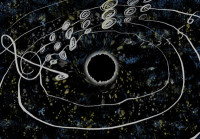RIKEN Research: Ringing black holes could put general relativity to the test

Typical overtone chords in the gravitational waves produced when black holes collide could be used to test general relativity, a mathematical analysis by a RIKEN physicist has shown [1].
When black holes merge, they generate gravitational waves, which ripple outward like sound waves from a ringing bell. In theory, these gravitational waves can be broken down into tones and overtones—like in music—based on their different frequencies and the rate at which they dampen and die out. But in practice, gravitational-wave detectors are not yet sensitive enough to definitively pick up the overtones.
However, cosmologists are keen to measure the precise oscillation pattern because it can tell them more about a black hole’s properties. In particular, the mass of the black hole and the rate at which it is spinning can be calculated from the damping rate and frequency.
“It’s like when you hear an instrument, you can understand if it is a guitar or a piano,” says Naritaka Oshita of the RIKEN Interdisciplinary Theoretical and Mathematical Sciences Program (iTHEMS).
To read more, please visit the related link.
Reference
- Oshita, N, Ease of excitation of black hole ringing: Quantifying the importance of overtones by the excitation factors, Physical Review D 104, 124032 (2021), doi: 10.1103/PhysRevD.104.124032

